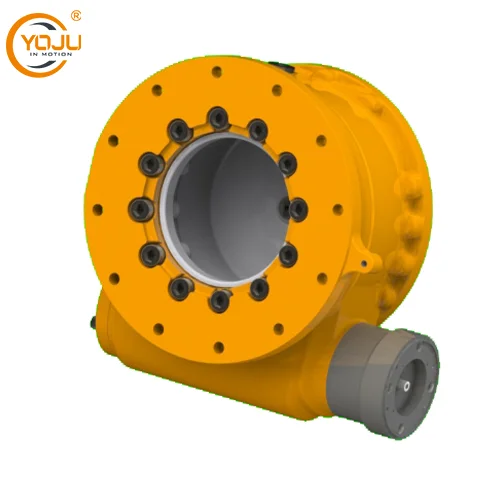- This topic is empty.
-
AuthorPosts
-
29/07/2025 at 10:17 #5806
As Concentrated Solar Power (CSP) technologies continue to evolve, solar tower systems have emerged as a leading solution for achieving high-efficiency solar energy conversion. A critical mechanical component in the operation of these systems is the slewing drive, a rotational device that enables precise tracking of the sun. As a professional slew drive manufacturing factory, YOJU will share the application advantages of csp-solar tower slewing drive for sale, emphasizing their role in optimizing energy output, enhancing system durability, and supporting intelligent solar plant operations.
Precision Solar Tracking
One of the foremost advantages of integrating slewing drives into CSP-solar towers is their ability to support accurate heliostat movement. Heliostats are mirror assemblies that reflect sunlight toward a central receiver at the top of a tower. Precise sun tracking is essential to maintain the correct angle of reflection throughout the day and year.
Slewing drives, particularly those with dual-axis capabilities, allow for high-precision adjustments in both azimuth and elevation angles. Their gear mechanisms, often enclosed and self-locking, prevent backsliding and ensure positional accuracy even in high-wind environments. This leads to maximum solar concentration, directly impacting thermal energy efficiency.
Enhanced Load Capacity and Structural Stability
CSP-solar tower heliostats are typically large and heavy due to the size of the mirrors and the structural framework. They are also subject to environmental loads such as wind, dust, and thermal expansion. Slewing drives are engineered to handle high axial, radial, and tilting moment loads, making them ideal for such demanding applications.
The enclosed design of the slewing drive protects internal gears and bearings from harsh environmental conditions, while materials like high-strength alloy steel ensure long-term performance. This mechanical robustness enhances the stability and reliability of the solar field, reducing the likelihood of misalignment or mechanical failure.

Compact Design with Integrated Motor Solutions
Modern slewing drives used in CSP applications are often designed as compact, integrated units that combine the gear mechanism with electric or hydraulic motors. This integration minimizes the space requirements of heliostat drive systems, enabling tighter array layouts and more efficient land use.
In CSP-solar tower installations where hundreds or thousands of heliostats are deployed, space optimization is critical. Integrated slewing drive units simplify mechanical layout, reduce cabling complexity, and allow for easier maintenance, contributing to lower system-level costs.
Reliability in Harsh Environments
CSP installations are typically located in arid, high-radiation desert regions to take advantage of direct normal irradiance (DNI). These environments can be highly corrosive due to sand, dust, and temperature extremes. Slewing drives designed for CSP systems are equipped with IP-rated seals, corrosion-resistant coatings, and low-maintenance lubrication systems to withstand these challenges.
Furthermore, the enclosed gear structure minimizes contamination risks and prolongs the operational life of the drive. As a result, CSP operators benefit from extended service intervals and reduced system downtime, which is essential for maintaining continuous energy production.
Seamless Integration with Control Systems
Modern CSP plants rely heavily on automated tracking algorithms and centralized control systems. Slewing drives can be easily integrated into these systems through built-in sensors and communication interfaces. With features such as position feedback encoders and torque limiters, slewing drives enable real-time tracking, error correction, and performance monitoring.
This level of integration supports predictive maintenance, allowing operators to detect abnormal load patterns or mechanical resistance before they lead to failures. It also facilitates remote control and diagnostics, which are particularly valuable in large, distributed heliostat fields.
Energy Efficiency and Operational Cost Reduction
Although slewing drives consume power to move and position heliostats, modern designs prioritize energy-efficient motors and gear mechanisms that minimize electricity consumption during tracking. The use of worm gears with self-locking properties means that once the heliostat is positioned, no additional power is needed to hold it in place.
This design feature significantly reduces energy waste and improves the overall net energy gain of the CSP plant. Over time, the lower operational costs of slewing drive-equipped systems contribute to more favorable Levelized Cost of Electricity (LCOE) metrics, enhancing the economic viability of solar tower projects.
Flexibility for System Scalability
Slewing drives are available in a wide range of sizes and configurations, allowing CSP developers to scale projects from pilot installations to full-scale commercial plants. Whether a system uses small heliostats for high-density arrays or larger mirrors for wide-field applications, slewing drives can be customized in gear ratios, torque ratings, and mounting formats to meet project-specific needs.
This scalability is essential in today' s evolving renewable energy market, where CSP projects must adapt to varying site conditions, investment levels, and performance goals.
Support for Hybrid and Thermal Storage Integration
CSP-solar tower systems are often integrated with thermal energy storage units, allowing them to deliver electricity even after sunset. Slewing drives, by maintaining precise solar tracking throughout the day, help maximize the amount of thermal energy collected and stored.
Moreover, as hybrid CSP configurations become more prevalent—combining photovoltaic (PV), gas backup, or energy storage—modular slewing drive systems enable flexible system design without compromising performance. Their adaptability supports innovative approaches to grid stability and dispatchable solar power generation.
Conclusion
The application advantages of CSP-solar tower slewing drives are numerous and far-reaching. From precision tracking and high load capacity to enhanced durability and system integration, these components play a pivotal role in enabling the reliable, efficient, and cost-effective operation of solar tower power plants.
As the demand for scalable and dispatchable solar energy solutions grows, the use of advanced slewing drive technology will continue to be a cornerstone of innovation in the CSP industry. Selecting the right slewing drive, tailored to site-specific and system-level requirements, is essential to unlocking the full potential of solar tower performance and profitability.
-
AuthorPosts
- You must be logged in to reply to this topic.